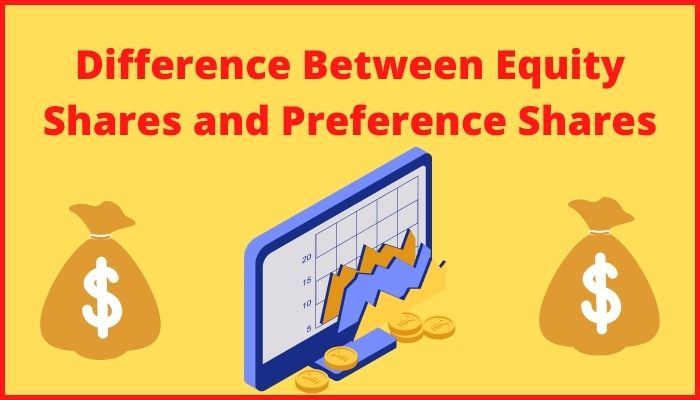A share is a unit of equity in a corporation with a marketable value determined by market forces. A firm’s share capital is made up of two forms of stock, according to Section 43 of the Companies Act of 2013, specifically equity shares and preferential shares.
Before discussing the difference between Equity shares and Preference Shares let’s check out the related terms.
Table of Contents
Companies sell these stocks to the general public in order to collect funds. The money generated would be used to help a business expand.
Equity stocks are a long-term form of funding for businesses because they are non-redeemable.
The corporation keeps its share capital across its existence and distributes it when it is wound up.
Equity owners are the real risk bearers of a corporation since they receive the residual share throughout liquidation. In reality, it’s where the Difference Between Equity Shares and Preference Shares arises from.

Key Points about Equity shares
The investors of equity stocks have voting rights as well as the right to collect surplus and claim corporation assets.
The dividend rate to be paid between these shareholders is determined by the firm ‘s leadership. Furthermore, these shares are marketable and can be sold without compensation.
Particularly, the number of shares owned by investors represents their equity of holding in a firm
They are usually listed on a stock exchange of the nation. Issue price, face value, market price, book value, intrinsic value, and other terms are used to describe the value of these stocks.
Categories of Equity Share
The liability side of a corporation ‘s balance sheet shows equity shares. They don’t have any exclusive categories, so they’re classified as common stocks. Regrettably, they are often classified as:
- Authorized share capital
- Issued share capital
- Subscribed share capital
- Bonus shares
- Paid-up capital
- Right shares
- Sweat equity shares
Benefits of Equity Share
- Investors in equity shares are entitled to significant dividends as well as value rises of their invested capital.
- Furthermore, their liquidity allows shareholders to easily sell them, creating yet another distinction between equity and preference shares.
- Equity shares, on the other hands, not only provide a constant source of funding but also make it easier for firms to raise credit.
- Large equity capital is regarded as advantaged by both investors and creditors. Moreover, corporations are not obligated to give a dividend to investors and the debt resulting from equity shares must be paid.

Preference share capital refers to the capital raised by a corporation by the sale of preference shares. These shares have a guaranteed dividend rate and an exclusive right of refusal to benefit and claim assets during a liquidation.
In addition, in respect of obligation and capital repayment these stocks are listed between debt and equity.
Preference shareholders, as equity shareholders, are part stakeholders of a corporation. They do not, however, have voting rights and therefore do not have the ability to regulate or influence company-related policies.
Furthermore, shareholders have no claim to the bonus stock, which is a significant Difference Between Equity Shares and Preference Shares.
Key Points about Preference shares
- Preference shares are like debentures in that they can be transformed into preferred stock. Moreover, issuers of preferred shares have the option to buy back the stocks at a later date.
- These securities pay out large dividends to shareholders but do not have a set end date. The management has the right to announce a dividend on preference shares, and it is not required in the event of a loss.
- This is the most important distinction between equity and preference shares. In addition, if a corporation chooses not to allocate a dividend in a given year, it must pay it to shareholders subsequently.
- Shareholders’ preference shares may be converted into equity shares, but they cannot be exchanged on the market.
Categories
These shares are listed first in the stockholders’ equity segment of the balance sheet, ahead of all other securities.
The main categories of preference shares are as follows:
- Cumulative preference shares
- Redeemable preference shares
- Non-cumulative preference shares
- Non-redeemable preference shares
- Participating preference shares
- Convertible preference shares
- Non-participating shares
Benefits of Preference Shares
- It is important to remember that dividends paid on preferred shares are not tax deductible.
- Furthermore, redeeming such shares burdens the company financially and depletes its reserves.
- Similarly, corporations must pay back arrears dividends when profits are received, particularly in the context of accumulated preference shares.
Difference Between Equity Shares and Preference Shares
These criteria, which are demonstrated in the table below, assist in easily the equity shares and preference shares difference:
| Feature | Equity Shares | Preference Shares |
| Definition | The amount of ownership in a firm is represented by equity shares. | When it comes to earning dividends or repaying money, preference shares have a massive advantage. |
| Dividend payout | Once all liabilities have been compensated off, dividends are given to shareholders. | When it comes to dividend payments, preference shareholders are offered a higher primary focus than equity shareholders. |
| Rate of dividend | The rate varies depending on the amount of money earned. | Dividends will continue to be paid at the same rate. |
| Bonus shares | These shares are eligible for a bonus if they are purchased with existing stock. |
These shares do not have a bonus if you already own them.
|
| Capital repayment | It is repaid at the closure. | It is repaid before any equity shares. |
| Voting rights | The stocks come with the ability to vote. | Voting privileges are not available with preferential shares. |
| Management Rights | The right to engage in the firm ‘s administration comes with an equity share. | Management rights are not extended by holding a preference share. |
| Redemption |
It is not redeemable.
|
It is redeemable. |
| Convertibility | It is not possible to convert shares. | It is possible to convert shares. |
| Arrears of dividend | Dividends in arrears are not available to investors. | Investors are likely to receive dividend arrears in addition to the current year’s dividend. |
| Capitalization | Over-capitalization is a significant likelihood. | There is a less tendency of over-capitalization. |
| Types | They are classified as a company ‘s general stock. | There are many different kinds. Participatory, non-participatory, convertible, and so on. |
| Financing Term |
It is used to provide long-term funding.
|
It can be used for both short & long-term financing. |
| Mandate to issue | A company’s equity share capital must be issued. | Preference share capital is not needed for all businesses. |
| Investment denomination | The number of equity shares is less. | The majority of preference shares have a large number. |
| Type of investors | It is appropriate for investors who are willing to take risks. | It’s a good choice for risk-averse investors. |
| Associated burden | The payment of an equity dividend is optional and completely dependent on the company’s profitability. | Companies have a legal obligation to pay dividends to their preference shares Investors. |

Important Points about Difference between equity share and preference share
- Both equity and preference shareholders make money in various ways, depending on the differences between the two types of shares.
- Although equity shareholders have the right to vote and can participate in company-related decisions, preference shareholders have the advantage when it comes to dividend payment.
- Preference shares, on the other hand, are a more suitable investment choice for risk-averse investors than equity shares, which have a significant risk element.
- Equity securities, on the other side, are a long-term investment object from the standpoint of a business owner. When comparison to preferred shares, it also has a lesser financial obligation to investors.
Conclusion
As an outcome, participants will choose the best investment choice from equity vs preference shares based on their risk tolerance and financial objectives. Irrespective, when it comes to investing, market consciousness should hold importance.
This is all from our side regarding Difference Between Equity Shares and Preference Shares. Let us know your views about preference and equity shares in the comment section.
Other Interesting blogs related to difference between equity and shares
Difference Between IPO and FPO
Difference Between Bulk Deal and Block Deal
Difference between Nifty and Sensex
Difference Between Shares and Debentures
FAQ About the equity and preference shares difference
Types of preference shares?
convertible, Non -convertible, cumulative, participating, Non-participating, Redeemable and non-redeemable.
How many Types of Preference shares able in India?
There are 7 Types of Preference shares.
Equity shares are also known as?
Equity shares are also known as Ordinary Shares.
Equity shares types?
authorized, issued, subscribed, paid up, rights, bonus, sweat equity.
Equity shares are also called as shares?
Equity shares are also called as Ordinary Shares.

